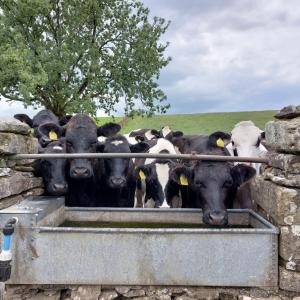
By vet Annie Kerr
As we are in the midst of the summer grazing season, parasite control for cattle youngstock will be at the forefront of most dairy and beef producers’ minds.
With much focus now being directed at sustainable worming practices that slow the development of resistance to the parasite treatments available, as well as being more environmentally aware, this time of year is a prudent opportunity to review what you are doing.
As vets the responsible use of veterinary medicines can be applied to wormers and flukicides. The objective should be to use products only when necessary. This decision ideally should be supported by testing such as worm egg counts (WEC) or blood testing for liver fluke and environmental/management risks such as weather conditions, grazing practices, stocking rates and the introduction of purchased animals. Reducing the use of these products has benefits in minimising the number of unnecessary treatments thereby reducing the exposure of both animals and the environment when it is not required.

Points to consider when worming this summer include:
1) Only treat animals where there is a genuine risk to their health. Use testing, clinical signs and parasite forecasting information such as the NADIS website: www.nadis.org.uk
2) Once treatment is established as necessary, choose the most appropriate product. This can be discussed with your vet or an SQP at an animal health product supplier.
3) Use the product correctly, following the instructions on the label to ensure the correct dosage is given, and calibrate any dosing guns to ensure they are working correctly and give the correct amount.
4) Ensure that animals are dosed for the correct weight, ideally weighing at the time of dosing.
5) Post treatment checks such as WEC can be performed to ensure that the product has been effective. This helps monitor for any possible resistance to the products used. Whilst resistance is much more common in sheep there have been some reports of gut worm resistance in cattle.
6) For parasite control to be sustainable pasture management is important. For example, best practice is for cattle in their first grazing season to be turned out onto grass that was not grazed by cattle last year. Where this is not possible monitor via WEC rather than following a set date routine calendar dosing plan. Look at the risks for your grazing fields and assess them into low, medium and high risk according to the stage of the grazing season and the animals which have grazed it previously. For example, in the spring a high risk pasture would be one that was grazed by 1st season youngstock last year. However, if it had been purely used for sheep in the previous year then it would be low risk. Further into the summer from around mid-July low risk fields would be re-seeds or silage aftermaths. Medium risk fields are those that have been grazed by adult cattle only on the assumption that they have a lower worm burden due to acquired age related immunity.
7) Ensure worming products are stored correctly. Most should be stored between 4-25°C and securely within your medicine cabinet.
8) Pay attention to use-by dates and how long products have been open for. Expired medicines will be less effective thereby posing the risk of treatment failure.
9) The disposal of any wormers should be according to the information on the label. Care should be taken to ensure that these products do not enter watercourses so do not pour them down the drain or sink.
10) Quarantine dose purchased cattle. Do not assume they have been dosed correctly. This avoids the potential introduction of resistant worms.